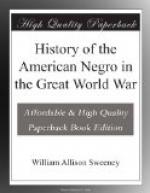“Near Sechault during the time the District men were making a big effort to capture the town,” said Johnson, “I was put in the front lines not fifty feet away from the enemy. A greater part of the time I was exposed to machine gun fire. I suppose I got my medal because I stuck to my men in the trenches and going over the top. Quite a few of the boys were bumped off at that point.”
Another hero was Benjamin Butler, a private. The citation with his Croix de Guerre read: “For displaying gallantry and bravery and distinguishing himself in carrying out orders during the attack on Sechault, September 29, 1918, under heavy bombardment and machine gun fire.”
“I did very little,” Butler said. “During this fight with several others, I carried dispatches to the front line trenches from headquarters. They decorated me, I suppose, because I was the only one lucky enough to escape being knocked off.”
Private Charles E. Cross of 1157 Twenty-first street, Washington, D.C. was awarded the Croix de Guerre, his citation reading: “For his speed and reliability in carrying orders to platoons in the first line under the enemy’s bombardment on September 29, 1918.” In some cases he had to creep across No Man’s Land and a greater part of the time was directly exposed to the enemy’s fire.
Private William H. Braxton, a member of the machine gun company of the regiment, whose residence was at 2106 Ward Place, Washington D.C., received the Croix de Guorre for “displaying zealous bravery.”
“An enemy party,” reads his citation, “having filtered through his platoon and attacked same in the rear. Private Braxton displayed marked gallantry in opening fire on the enemy and killing one and wounding several others, finally dispersing the entire party.”
“The men who stuck
by me when death stared them in their faces,”
said Braxton, “deserve
just as much credit as I do. I was only the
temporary leader of
the men.”
Corporal Depew Pryor, of Detroit, Michigan, was awarded the Medal Militaire, one of the most coveted honors within the gift of the French army, as well as the American Distinguished Service Cross. Pryor saw Germans capture a Frenchman. Grabbing an armful of grenades, he dashed upon the Germans killing, wounding or routing a party of ten and liberating the Frenchman.
Sergeant Bruce Meddows, 285 Erskine street, Detroit, Michigan, brought home the Croix de Guerre with silver star, which he won for bringing down an aeroplane with an automatic rifle.
To have forty-six horses which he drove in carting ammunition up to the front lines, killed in five months was the experience of Arthur B. Hayes, 174 Pacific Avenue, Detroit, Michigan. He returned home sick, with practically no wounds after risking his life daily for months.
Sergeant George H. Jordan of Company L, whose home was in Boston, Mass., won the Croix de Guerre and palm for taking charge of an ammunition train at Verdun, when the commanding officer had been killed by a shell. He saved and brought through eight of the seventeen wagons.




